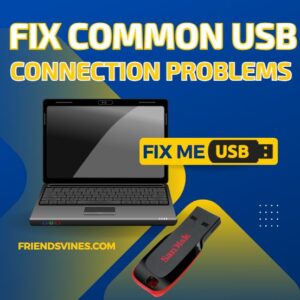How to Fix Common USB Connection Problems in Windows
Learn how to fix common USB connection problems in Windows to ensure smooth data transfer and device functionality. Get expert insights and solutions to common issues.

Introduction
If you’re a Windows user, you’re probably familiar with the convenience and versatility of USB connections. USB (Universal Serial Bus) is a standard interface that allows you to connect various peripherals and devices to your computer. While USB connections are generally reliable, sometimes issues can arise, causing frustration and hindering productivity.
In this comprehensive guide, we will walk you through various common USB connection problems that Windows users might encounter and provide detailed solutions to troubleshoot and fix them. Whether you’re dealing with a malfunctioning USB device, slow data transfer, or unrecognized USB ports, we’ve got you covered.
How to Fix Common USB Connection Problems in Windows
1. USB Device Not Recognized
If you receive a “USB Device Not Recognized” error message, don’t panic. This issue often occurs due to faulty connections or outdated drivers. Follow these steps to resolve the problem:
- Unplug the USB device and plug it back in. Sometimes, a loose connection can cause this error.
- Try connecting the device to a different USB port on your computer. The current port may be damaged or not functioning correctly.
- Check Windows Device Manager for any warning symbols or exclamation marks next to the USB device. If you see any, right-click on the device and select “Update Driver Software.”
2. Slow Data Transfer Speeds
Slow data transfer over USB can be frustrating, especially when you’re trying to transfer large files. Several factors can contribute to this problem:
- USB Port Version: Ensure that you’re using a USB port that matches the device’s speed requirements. USB 3.0 or higher ports offer faster data transfer than USB 2.0.
- Background Applications: Close unnecessary applications running in the background, as they may consume system resources and slow the transfer speed.
- Disable Write Caching: Disabling write caching for the USB device can improve transfer speeds. To do this, go to Device Manager, right-click on the USB device, select Properties, go to the Policies tab, and uncheck “Enable write caching on the device.”
3. USB Device Keeps Disconnecting and Reconnecting
If your USB device repeatedly disconnects and reconnects on its own, follow these steps to address the issue:
- Check the USB Cable: The problem may be with the USB cable itself. Try using a different line to see if the issue persists.
- Power Management Settings: Some USB devices may have power-saving features that cause intermittent disconnections. In Device Manager, locate the USB device, go to Properties, and uncheck “Allow the computer to turn off this device to save power.”
- USB Selective Suspend: Disable USB Selective Suspend to prevent Windows from suspending individual USB ports. Go to Power Options > Change Plan Settings > Change Advanced Power Settings > USB Settings > USB Selective Suspend.
4. USB Device Not Detected in File Explorer
If you plug in a USB device, but it doesn’t appear in File Explorer, try these solutions:
- Disk Management: Open Disk Management (right-click on the Start button and select Disk Management) and look for the USB device. If it’s there, assign it a drive letter.
- Update USB Drivers: Outdated or corrupt USB drivers can cause detection issues. Use Device Manager to update the drivers or visit the manufacturer’s website to download the latest drivers.
- Reinstall USB Controllers: In Device Manager, right-click on the USB controllers and select “Uninstall device.” Restart your computer, and Windows will automatically reinstall the controllers.
5. USB Port Not Working
If a specific USB port is not working, it might be due to a hardware or driver issue:
- Check for Physical Damage: Inspect the USB port for physical damage. Bent pins or debris inside the port can cause connection problems.
- Update Chipset Drivers: The USB port’s functionality is often tied to the chipset drivers. Visit your computer manufacturer’s website to download and install the latest chipset drivers.
- Use USB Troubleshooter: Windows has a built-in USB Troubleshooter that can help identify and fix common USB issues. Type “Troubleshoot” in the Start menu search bar and select “Troubleshoot settings.” Then, click on “Additional troubleshooters” and run the “Hardware and Devices” troubleshooter.
6. USB Device Shows Up as “Unspecified” in Device Manager
When a USB device is listed as “Unspecified” in Device Manager, follow these steps:
- Reinstall the Drivers: Right-click on the USB device and select “Uninstall device.” Disconnect the device and restart your computer. Upon restarting, reconnect the USB device, and Windows should automatically reinstall the drivers.
- Check Compatibility: Ensure that the USB device is compatible with your version of Windows. Visit the manufacturer’s website to download compatible drivers if needed.
- Check for Windows Updates: Keeping your Windows operating system up to date can resolve compatibility issues. Go to Settings > Update & Security > Windows Update and check for updates.
7. USB Device Malfunctioned
When a USB device malfunctions, you may see an error message indicating so. Follow these steps to fix the problem:
- Unplug and Reconnect: Disconnect the USB device, wait for a few seconds, and then reconnect it. Sometimes, this simple step can resolve the issue.
- Test on Another Computer: Verify if the USB device is functional by testing it on another computer. If it works correctly on a different system, the problem might be with your Windows configuration.
- Run Hardware Troubleshooter: Use the built-in hardware troubleshooter in Windows to diagnose and fix USB device malfunctions. Type “Troubleshoot” in the Start menu search bar, select “Troubleshoot settings,” and run the “Hardware and Devices” troubleshooter.
8. USB Device Driver Installation Failed
When you encounter driver installation failures for USB devices, try these solutions:
- Use Compatibility Mode: If you have the driver installer file, right-click on it, select Properties, go to the Compatibility tab, and check “Run this program in compatibility mode for.” Choose an older version of Windows and proceed with the installation.
- Update Windows: Make sure your Windows operating system is up to date. Sometimes, driver issues are fixed in Windows updates.
- Try a Different USB Port: Plug the USB device into another USB port on your computer. The current port may have a conflict with the driver installation.
9. USB Device Overheating
If your USB device becomes excessively hot during use, follow these steps:
- Disconnect the Device: Unplug the USB device immediately if it starts overheating. Continued use could cause damage to both the device and your computer.
- Allow Cooling Time: Give the device some time to cool down before reconnecting it. If it continues to overheat, it might be malfunctioning and needs repair or replacement.
- Use External Power (if applicable): Some USB devices, like external hard drives, have their power supply. Connect the device to a separate power source instead of relying solely on the USB port’s power.
10. USB Device Not Charging
If your USB device is not charging when connected to a computer, consider the following:
- Check USB Cable: Ensure that the USB cable you’re using supports data transfer and charging. Some cables may only support data transfer without charging capabilities.
- Enable Charging Mode: Some smartphones and tablets have charging modes that you need to enable manually. Check the device’s settings or user manual to find the charging mode option.
- Check Power Output: The USB port’s power output may not be sufficient to charge the device. Try connecting it to a powered USB hub or a USB port with higher power output.
FAQs Fix Common USB
- How do I know if my USB port is working correctly?
- Connect a known working USB device to the port and see if it gets recognized by your computer. If it does, the port is likely functioning correctly.
- Can I use a USB 3.0 device on a USB 2.0 port?
- Yes, you can use a USB 3.0 device on a USB 2.0 port.
- Why does my USB device keep disconnecting and reconnecting?
- The issue may be caused by a loose connection, faulty cable, power-saving settings, or driver problems.
- How can I update USB drivers in Windows?
- You can update USB drivers through Device Manager. Right-click on the USB device, select “Update Driver Software,” and follow the on-screen instructions.
- My USB device shows as “Unspecified” in Device Manager. What should I do?
- Try uninstalling the device from Device Manager, disconnecting it, restarting your computer, and then reconnecting the device.
- Why is my USB device not charging when connected to my computer?
- The issue could be due to an incompatible USB cable, a disabled charging mode on the device, or insufficient power output from the USB port.
Others
Fix Common USB connection problems
Fix Common USB connection problems in Windows can be frustrating, but with the right troubleshooting steps, most issues can be resolved. Whether it’s a malfunctioning USB device, slow data transfer, or driver-related problems, this guide has covered a wide range of solutions.
Fix Common USB connection problems
Remember to check the physical condition of your USB ports and cables, keep your drivers up to date, and utilize Windows’ built-in troubleshooting tools when encountering issues. By following these tips, you can ensure smooth and efficient USB connections, making your computing experience more enjoyable.

Hi friendsvines.com,
I found your details on Google.com and I have looked at your website and realized your website has great design but your website ranking is not good on all search engines Gogle, AOL, Yahoo and Bing. friendsvines.com
Our main focus will be to help generate more sales & online traffic.
We can place your website on Google’s 1st page. We will improve your website’s position on Google and get more traffic.
If interested, kindly provide me your name, phone number, and email.
Your sincerely,
Alora Finely
[…] pace? If you’re nodding your head, you’re not alone. Downloading large files, software, videos, or games can be a time-consuming ordeal. But fear not, because Internet Download Manager […]